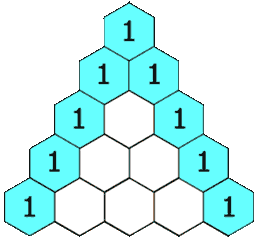|
|
A life of learning in Leiden. The mathematician Frans van Schooten (1615-1660)
Jantien Dopper geeft in haar proefschrift onderstaande beschrijving van dit handschrift.
| author
| various authors (see the contents); some material has been conceived by Frans
van Schooten himself
| | scribe
| Frans van Schooten jr. (f. 1r.) and Godefroy van Haestrecht [+]
| | contents
| Various notes on mathematical subjects, for a fair part copied from existing
works, and for a small part his own work. Two documents are inserted in the binding,
one at the beginning and one at the end. The first is a pamphlet entitled
Problemaastronomicumissued by Johan Stampioen in 1638 [Stampioen, 1638], with
notes on it written by Frans van Schooten. The second is an autograph of Godefroy
de Haestrecht which deals with page 378 of Géométrie.
The mathematical notes include notes on the mathematical work of Descartes (f.
1r.-v., f. 4v., f. 9r., f. 13r.-14r., f. 20r., f. 51v.-53r., f. 54v., f. 55v.-60v., f. 94r.)., various
notes from lessons of Jacob Golius (f. 5r.-6v., f. 20r.-21r., f. 29r., f. 30r.-31r., f. 56r.)
and Christiaan Otterus (f. 12r., f. 13r., f. 25v., f. 59r., f. 92r.-93r.). The copied fragments
include parts from the followingworks: Viète's Apollonius Gallus [Viète, 1600]
(f. 21v.-22r.); Archimedes's On Spirals (f. 26r.-29v.); Oughtred's Arithmeticae in numeris
et speciebus institutio: quae tum logisticae, tum analyticae, atque adeo totius
mathematicae quasi clavis est [Oughtred, 1631] (f. 31v.-41r.); Stifel's Arithmetica
integra [Stifel, 1544] (f. 41r.-48v.); Bachet's edition of Diophantus's Arithmetica (f.
44v.-48r.); Descartes's Compendium Musicae (f. 60r.-83v.); work of Albert Girard
(f. 95v.-96v.); Weland's Strena Mathematica [Weland, 1640] (f. 98r.-v.); Stampioen's
Algebra ofte nieuw stel-regel [Stampioen, 1639] (f. 101v.-102r.); Simon Stevin's Arithmetique,
[Stevin, 1585a] (f. 103r.); Francesco Maurolico Arithmeticorum libri duo
[Maurolico, 1575], (f. 103v.).
| | language
| Latin, French, Dutch. The majority of the text is in Latin, some notes related to
Descartes are in French, and a few notes are in Dutch.
| | date
| between 1632 and 1641 [+]
| | origin
| Leiden
| | systematic classification
| algebra: equations, cossist
analytic geometry: equation of curves
applications: astronomy, fortification, music theory, optics
classical problem: Pappus problem
arithmetic: general, decimal system, elementary operations, fractions
combinatorics: general
| | names mentioned
| Apollonius, Archimedes, Claude Gaspar Bachet, Isaac Beeckman, Tycho
Brahe, René Descartes, Diophantus, Jacob Golius, Albert Girard, Francesco
Maurolico,Menaechmus, Christiaan Otterus, Pappus, Peter Roth, Francisco de Salinas,
Frans van Schooten jr., Gioseffo Zarlino, Johan Stampioen the Younger, Simon
Stevin, Michael Stifel,Woldeck Weland
| | evidence
| Godefroy van Haestrecht is identified as the scribe of a note attached to the
binding by the content of the note. The note discusses algebraic manipulations
of page 378 of the Géométrie. In a letter to Frans van Schooten, Descartes refered
to this "note of Mr Haestrecht on page 378", on which Frans van Schooten jr. had
sought Descartes's advice, [Descartes, 1898, 577-578].
The manuscript contains a date on f. 1r.: "Anno 1632 5 Decembris". At that time,
Frans van Schooten jr. was 17 years of age. The manuscript contains however several
references to works which were published after 1632. Therefore, we take 1632 as
terminus post quem. The content of the manuscript suggests that the greater part
of the manuscript was written before 1641, the year in which Van Schooten traveled
to France.
|
 proefschrift: A life of learning in Leiden. The mathematician Frans van Schooten (1615-1660) proefschrift: A life of learning in Leiden. The mathematician Frans van Schooten (1615-1660)
|
Geheeltallige driehoeken
Geheeltallige driehoeken zijn driehoeken waarvan de lengte van de zijden gehele getallen zijn.
Daar zijn er heel veel van. Ieder drietal gehele getallen voldoet mits voor alle drie de getallen geldt dat de som van welke twee getallen dan ook, altijd groter is dan het derde getal. In de Elementen van Euclides is dit propositie 20.
Zo voldoet wel de driehoek met zijden 2, 3 en 4, maar bestaat er geen driehoek met zijden 2, 3 en 7.
De bekendste geheeltallige rechthoekige driehoek is die met lengte van de zijden 3, 4 en 5.
Andere bijzondere geheeltallige driehoeken hebben naast geheeltallige lengtes van de zijden ook geheeltallige lengte van de hoogtelijn, de deellijn of de stukken van de overstaande zijde die door de hoogtelijn of deellijn doorsneden wordt.
In GN108 staan de nodige voorbeelden.
|
|
Kegelsneden
Met eenvoudige hulpmiddelen kon Frans van Schooten een hyperbool, parabool of ellips tekenen.
 kegelsneden kegelsneden
Pythagoreïsche drietallen
Frans van Schooten Junior maakte een overzicht van veel gebruikte Pythagoreïsche drietallen.
Die gebruikte hij om te rekenen aan geheeltallige driehoeken.
 geheeltallig geheeltallig
|
 Mechanische constructies om parabolen en ellipsen te tekenen (kegelsneden)
Mechanische constructies om parabolen en ellipsen te tekenen (kegelsneden) top
top






